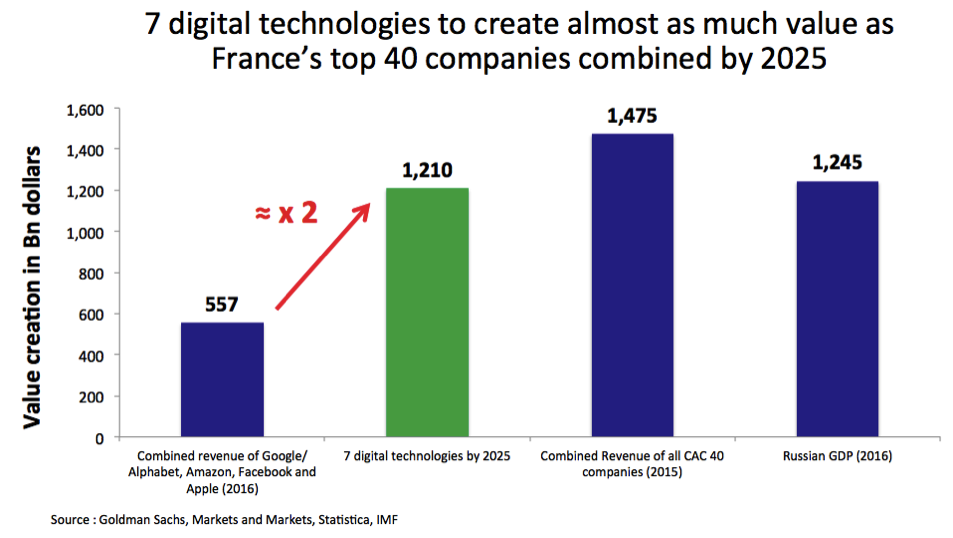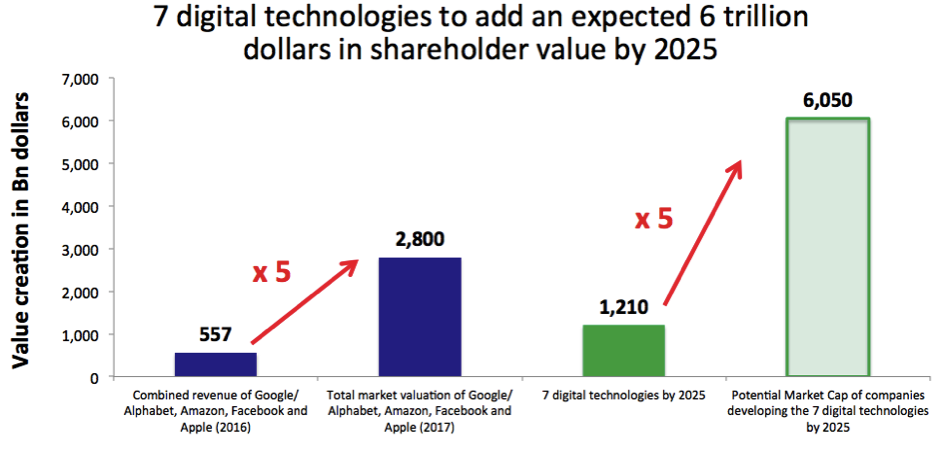What are the most sizable market segments in the industrial internet space? Which sectors stand as the most promising? What use cases may turn out as most conducive to growth and profitability? What technologies should we invest in? These questions prove crucial to:
- Established digital players such as IBM, Accenture and Fujitsu,
- Startups-turned-multi-billion-dollar-corporations like Google, Apple, Facebook, Microsoft and Amazon,
- Incumbent industrial companies looking to digitalize their value chains,
- Entrepreneurs searching for the next opportunity,
- Innovation consultants helping their clients in making sensible investment decisions.
To get a sense of where we’re going, I’ve drawn from over 100 conversations with C-level executives (Board Members, CEOs, Managing Directors, CFOs, CMOs and several CIOs), investors and startup founders — some of which were published on The Innovation and Strategy Blog. I’ve also read Goldman Sachs’ Profiles In Innovation and thumbed through a Cybersecurity survey from Markets and Markets to quantify growth opportunities.
The results explain why investors prefer digital technologies stocks over alternatives. Here’s why.
Digital technologies to create almost as much value as France’s top 40 companies combined in just 7 years

$1210 adds up to twice to the combined revenue of Google, Amazon, Facebook and Apple as of 2016.
This doesn’t refer to profit nor market capitalization but annual sales. These not-so-long-ago-startups-turned-billion-dollar companies epitomize Silicon Valley’s success. They’re grouped here in one index.
Multiply the revenue of Google, Amazon, Facebook, Alphabet, Apple by 2 and you get the expected sales of seven digital technologies by 2025 according to Goldman Sachs and Markets and Markets. Several things stand out:
- First of all, these seven digital technologies, offering a compound average growth rate ranging from 4% to 66%, include: factory of the future, artificial intelligence (AI), blockchain, cybersecurity, virtual reality (VR) and augmented reality (AR), connected agriculture, and drones. In fairness, value is only partly generated from new streams. But, as indicated later, 56% of the $1210 billion comes from novel business lines.
- Second of all, this value is unlocked in just seven years—a much shorter timespan than Google, Amazon, Facebook and Apple need to reach their prime.
$1210 billion accounts for 80% of the French Stock Market Index (CAC 40) as of 2015.
The French Stock Market Index boasts a diversified portfolio of global leaders, such as:
- an oil company, Total,
- an advanced pharmaceutical player, Sanofi,
- a renowned luxury corporation, LVMH,
- a fashionable cosmetics company, L’Oréal,
- a first-in-class energy management organization, Schneider,
- several global retail players including Carrefour and Auchan,
- a prominent European telecommunications operator, Orange.
In all honesty, the CAC 40 rests short of startups-turned-unicorns like Silicon Valley rolls out at scale. But the point remains: in just eight years, innovation is set to create the equivalent of 80% in value generated by the top 40 corporations of Europe’s second economy—a stunning development.
$1210 billion is equal to the Russian gross domestic product (GDP) standing at $1245 billion as of 2016.
Again, in just seven years, digital technologies should unlock as much value as the Russian economy, a major player in world affairs and a permanent member of the UN’s Security Council.
7 digital technologies to add an expected 6 trillion dollars in shareholder value by 2025

A brief history of growth strategies
Consider the implications for shareholders and analysts: in the 1990s, successful business strategy involved expanding activities overseas as the fall of the Berlin wall was opening new markets, according to François Darchis, Senior Vice President, Innovation and Development Vice President in charge Information Technologies, the Industrial Merchant business line and the Group’s Sustainable Development program at Air Liquide, an industrial gaz leader. In the beginning of 2000, investment in network infrastructure meant that much could be outsourced. Helping clients cutting operating costs and improving profit margins proved crucial to capturing growth. Since 2009, the global economy sits awash in capital despite sluggish demand. Existing capacity appeared underutilized. Corporations tended to reward their shareholders through dividend buybacks rather than capital investment. But this is changing, according to Jan Hatzius, chief economist of investment bank Goldman Sachs: “There is a bigger contribution from business investment to productivity growth in the next couple of years.”
Digital business stand as the new growth paradigm
But if seven technologies are to create $1210 billion by 2025, then, combined shareholder valuation could reach new heights. Google, Facebook, Amazon, Apple and Alphabet, produce $557 billion in revenue as of 2016 while their market cap stands at 2800 billion dollars. Assuming a similar multiple, total market valuation should turn up at $6050 Bn by 2025.
To sum-up : Digital technologies are set to create almost as much value as France’s top 40 companies combined in just 7 years. That adds up to twice to the combined revenue of Google, Amazon, Facebook and Apple as of 2016. Expected shareholder value creation stands at 6 trillion dollars. Established companies should invest more in digital transformation if they want to build a sustainable competitive strategy.
[…] previous articles, I indicated that digital technologies should create as much value as the Russian economy while showing, at the same time, the potential […]
[…] … we develop innovative use cases leveraging value-creation technologies : there’s $1210 Bn up for grabs […]
[…] why is it important for France to be producing unicorns in the first place? How does this tie into value creation and jobs? Plus, are there any signs showing whether the country is on track to meeting the stated […]
[…] to bring greater efficiency in production chains that have been along for many years? What role do novel technologies such as artificial intelligence play in process automation and productivity gains? CEO and founder […]